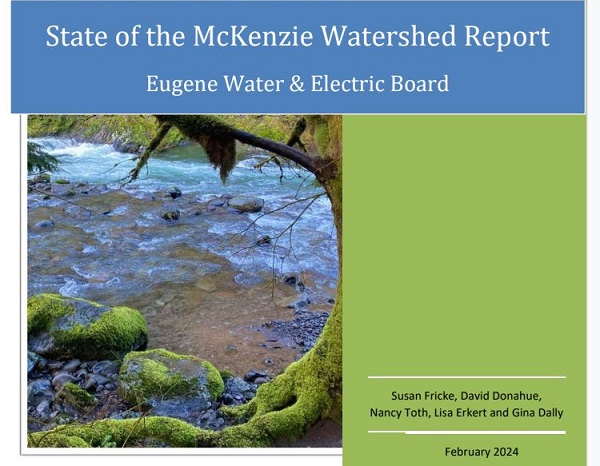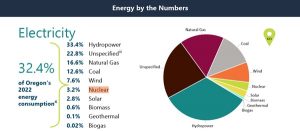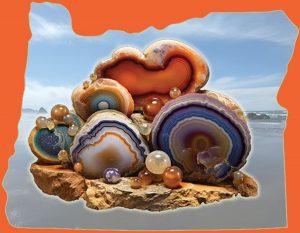EWEB expects post-fire impacts to the McKenzie for the next few years
8 min read
[00:00:00] John Q: EWEB’s fifth annual ‘State of the McKenzie Watershed’ report says we should expect impacts from the Holiday Farm Fire over the next few years. On March 5:
Susan Fricke (EWEB, Water Resources and Compliance Assurance): We have a healthy functioning watershed. Did we see some impacts in 2023 from the Holiday Farm Fire and other fires that have impacted our watershed? Yes. Do we expect to? Yes.
Generally, your roots start degrading three to five years out after a large fire. We’re three and a half years out now. So we do expect to see some impacts and that’s why EWEB has invested so heavily with our partners and why we’re receiving so much funding from other agencies to be able to do these kind of investments for post-fire impact up in the watershed.
[00:00:42] John Q: As roots in the burned area degrade, we could see more flooding and erosion, with more debris and sediment in the river.
[00:00:50] Susan Fricke (EWEB, Water Resources and Compliance Assurance): So where we saw the impacts were during our storms. If you all remember, we had a really decent rain-on-snow event in December. It was probably one of our largest ones that we’ve had since the fires. And so, our total suspended solids—kind of how dirty the water is—we definitely saw levels that were higher in that December storm event.
[00:01:06] Simmonds Creek: We had a little bit of debris coming through there. We did have some banks to stabilize. And again, that’s why we’re investing in these areas up there and doing some of our larger-scale restoration projects. That’s why we did lots of planning because we are expecting to see some of this post-fire.
[00:01:20] John Q: Those large-scale projects protect the water supply by restoring floodplains where the river spreads out, slows down, and deposits that extra sediment from the burned area. The floodplains also provide new habitat.
[00:01:34] Susan Fricke (EWEB, Water Resources and Compliance Assurance): As far as floodplain restoration, we’ve been doing some exciting stuff this year. Finn Rock is officially done. During that big rain-on-snow event in December, it fared really well. No wood exported out of the project is great. It’s how we designed it. The sediment moved around a little bit in between, but not much.
[00:01:51] These projects are so important for juvenile rearing. That’s our number one thing that we’re missing in the watershed. So they provide lots of that, and it functioned really well in December for that.
[00:02:00] We want to grow thriving baby salmon, but then we’re also there for those redds too, which is the salmon eggs. So before the project, we had about five to 10 redds per year in this area. Two months after we opened up this project, we had 65 redds this year. So this was just the first year. So we’re very excited to see how this keeps working.
[00:02:19] And then we’ve already talked about Quartz Creek today. (Thank you for bringing that one up.) This was very much a partnership effort. This time McKenzie Watershed Alliance applied for a NOAA transformation grant, and it was a $7.5 million grant they were awarded. This time they will carry the contract for it, and they’re overseeing this project.
[00:02:37] And one part of it was that the bridge was installed this fall. And then that implementation for this project will be in the summer of 2025. So not this year, but next year. But we needed a bridge that spanned a little bit wider so that we could do a bigger restoration project because the bridge (I think we all went out to the field trip) was pretty much a big choke point for that. So we need to have a wider bridge.
[00:02:57] John Q: Susan said the water quality team will also start regular sampling from Springfield.
[00:03:02] Susan Fricke (EWEB, Water Resources and Compliance Assurance): After April, we had no rain all the way until August, and then we kind of had a little crazy summer thunderstorm event that mobilized some of the urban areas.
[00:03:09] So, because we haven’t sampled any of the pesticides, we went out and grabbed a sample at a time when we normally necessarily wouldn’t grab it. And we found some really high bacteria and TKN (Total Kjeldahl Nitrogen) levels, which is a kind of nitrogen.
[00:03:20] So we reached out to the city of Springfield. We’re coordinating with them on a monitoring program for looking at these urban outflows. We’re going to start sampling this month, monthly. We’re going to look at bacteria and TKN, which is that nitrogen, and see what kind of bacteria it was. Is it human? Is it dog?
[00:03:37] A few years back, we worked with the city of Springfield because we did another similar study of this. It was ‘16 or ’18, we were back in there. And we found out that it was a lot of dog that was causing the bacteria issues. So they went out and did some more education.
[00:03:51] We’re also really excited to work with the city of Springfield. They’ll be doing a lot of outreach and education once we find out what’s going on. We also want to make sure there isn’t some kind of sewer cross-contamination happening because again, this was just one isolated sampling event.
[00:04:03] John Q: With EWEB self-funding time-critical work right after the fire, the staff has done a great job getting reimbursed.
[00:04:10] Susan Fricke (EWEB, Water Resources and Compliance Assurance): I’d like to give a special thanks to Matthew Miller, Tegan DeBolt, and Gina Dally, because not only did they figure out the numbers, they were able to finally get more reimbursements. So we have more revenue last year than we had expenses because, as you all remember, EWEB has done a lot of frontloading for the budgets for all this work because we have the investment to be able to do that.
[00:04:30] So we were able to get money back from Oregon Department of Forestry, from Oregon Watershed Enhancement Board, but it was this team effort at EWEB that was able to get those reimbursements back because it wasn’t quick or easy. So a big thank you to those folks that worked on it.
[00:04:44] …And finally, I just wanted to say thank you to my staff. They’re the ones who write these reports and put together the presentations: David Donahue, Nancy Toth, Lisa Erkert, and Gina Dally. They do so much for us and, of course, our lab staff as well that are processing the samples. So thank you all so much.
[00:05:00] John Q: One commissioner wants Springfield to contribute to the watershed, now that they are also drawing from the McKenzie.
[00:05:07] John Brown (EWEB commissioner): They’re going to be taking their drinking water out of the same source we are. Why aren’t they paying? Why aren’t they helping us with the drills and the funding and everything else? And I still want to keep banging on that table. I think they need to take some stewardship as well. Like, you shouldn’t be footing the whole bill now that they’re taking drinking water out of McKenzie.
[00:05:24] John Q: Following up about reservoir drawdowns:
[00:05:28] John Barofsky (EWEB commissioner): Other communities have weighed in on water quality with the drawdowns of the dams. You saw what happened in Sweet Home and those areas. Are we thinking about wanting to have our voice be heard on those issues as well? I mean, I know those communities and those water districts sent some correspondence to the governor, to the legislature saying that these drawdowns do have a dramatic impact.
[00:05:53] It may not be as bad here as it was in Sweet Home, but I know when they draw down Cougar, the cleanest water that we have, it gets turbulent. And then also we’re looking at the Willamette and they’re bringing down Lookout and they’re bringing down Fall Creek and if you saw the Willamette when they brought down Lookout, it was there as well.
[00:06:16] As somebody who actually saw Foster Lake this summer, it would just be that there is concerns about the impact of the sediment that comes out when you do a hard dropdown and to let people know that that is a concern for our water source.
[00:06:30] Not that I’m against the reason why the drawdowns are there, but to note that there are other impacts that were not readily seen when the judge put that in. The judge didn’t know that Foster Lake was going to turn into a mud pit when he ordered that.
[00:06:45] And so I’m all in favor of trying to restore the habitat, but just letting them know that there’s other impacts besides what it’s doing to the juvenile fish, is what I would hope to see.
[00:07:01] Mike Masters (EWEB, water operations manager): This is also a fairly hot topic with the Oregon Water Utility Council.
[00:07:05] So we’re monitoring. I’m active in that and Jason Heuser is active in that. So, as you can imagine, it’s a very, very concerning topic for the overall water community. So we’ll monitor it through that group as well and…take an action item on that.
[00:07:25] John Barofsky (EWEB commissioner): The next question I have is, this is all great, what we’re doing at the McKenzie. Have we started to figure out a plan on some of these same action items that we’re going to want to do on the Willamette, as far as monitoring, as far as restoration, as far as, you know, if we’re going to build a $100 million plant on the Willamette, are we thinking long-term enough to figure out what kind of budget we’re going to need to be doing these types of things on the Willamette?
[00:07:53] Susan Fricke (EWEB, Water Resources and Compliance Assurance): I think one of the things we’re waiting on is our permitting and to see what mitigation actions where and when and how much are going to be required to figure out where we’re going to be doing some investments. And I think that’s very strategic on behalf of EWEB. Some of those I heard are going to be in by June. So that’s very timely brought up.
[00:08:10] What we’re also doing is working on our Drinking Water Source Protection Plan. We need to develop one of those for the Middle Fork (Willamette) and the Coast Fork (Willamette) for part of this. So it’s something that we were just talking about as part of my goals for the year for our department. We’re starting these things. We’re going to start drafting them.
[00:08:23] John Q: EWEB released its first State of the Watershed report, in February 2020.
[00:08:31] Karen Kelley (EWEB, chief operations officer): I would like to acknowledge our first ‘State of the Watershed’ report. Our leader, Karl Morgenstern, who’s a foundational leader of the program, retired. We do want to thank him for all he’s done to bring us to where we are today.
[00:08:45] He was also a recipient of the General Manager’s Award before his retirement… he’s helped lead this group to be leaders, not just in Oregon in source protection, but actually nationally.
[00:08:54] And then I also want to thank Mike (Masters) and Susan (Fricke) and all of the source protection team. They have carried this torch that Karl began and continue to make these investments and make this difference in our water quality, not just for EWEB, but for the entire community and upriver as well.
[00:09:10] John Q: EWEB shares the 2023 ‘State of the McKenzie Watershed,’ which is currently Eugene’s sole source for its water supply.






